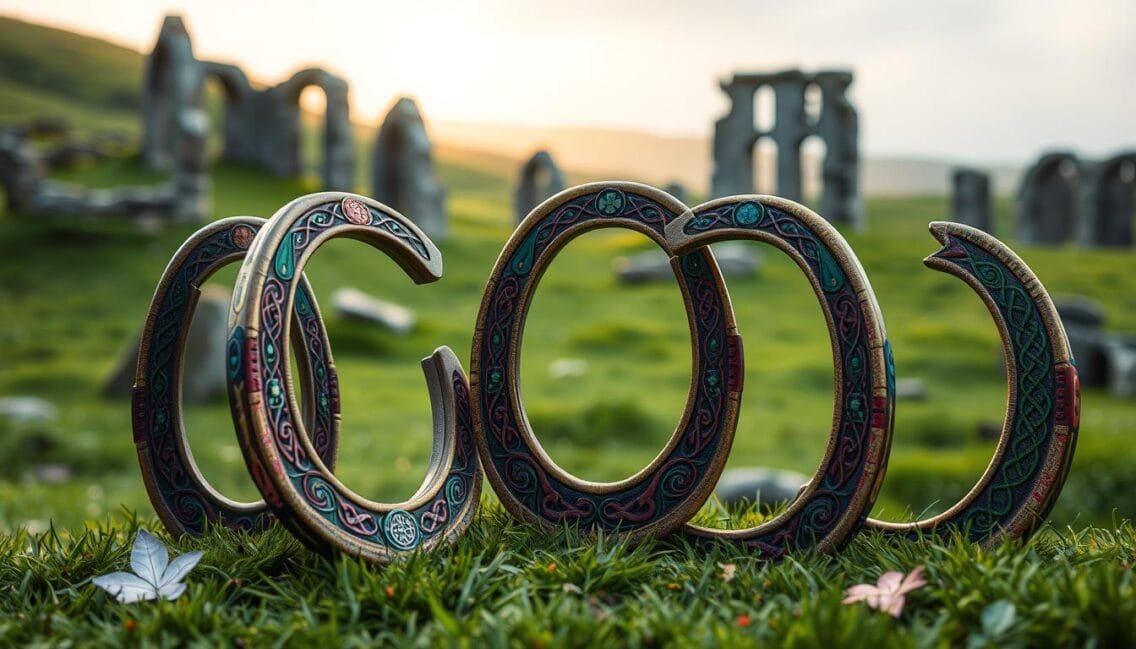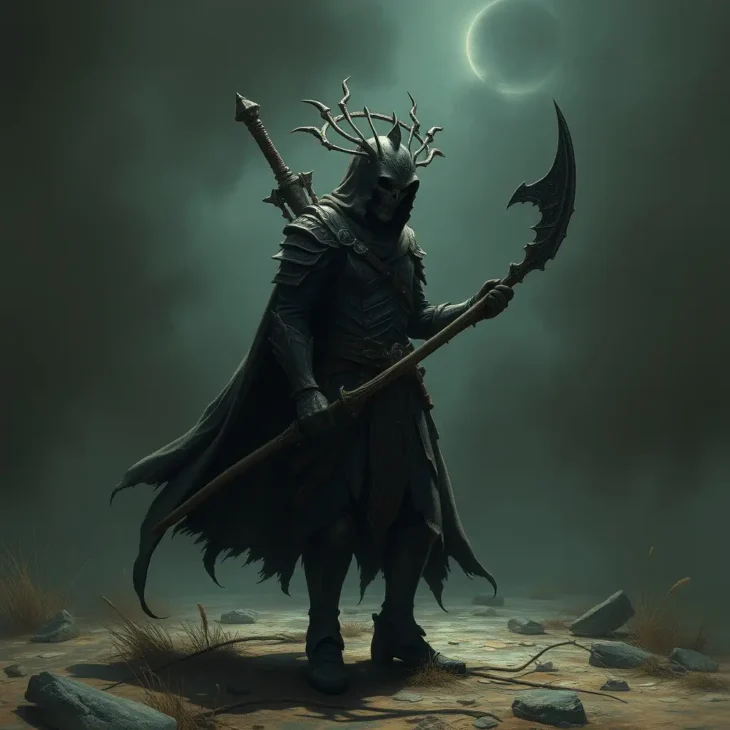Irish Folklore: The Power of Horseshoes & Evil Protection

I’ve always been drawn to Irish heritage and its folklore. The humble horseshoe holds a special place in this world. It’s found in old barns and modern jewelry, promising to keep evil away. Let’s explore the history and meaning behind the horseshoe’s power to protect us.
The horseshoe’s link to protection comes from ancient Celtic and Norse beliefs. They saw the crescent shape and iron as magical. In Irish tales, the horseshoe was a strong charm, keeping evil at bay and protecting homes and communities.
The number seven was key, tied to the horseshoe’s holes. This added to its mystical power. Whether pointing up or down, the horseshoe was seen as a barrier against dark forces.
This tradition of using horseshoes for protection has lasted for centuries. It’s a big part of Irish culture. As you learn more about Irish folklore, you’ll see the horseshoe as a symbol of hope and the enduring power of ancient beliefs.
The Power of Horseshoes: Irish Folklore and the Secrets of Keeping Evil Away
In Irish folklore, horseshoes are seen as powerful talismans. They protect against evil spirits and bring good luck. This tradition, rooted in Celtic beliefs, has lasted for centuries, fascinating people worldwide.
Horseshoes as Protective Talismans in Irish Culture
Horseshoes are symbols of luck and protection in Irish folklore. Their U-shape is believed to mirror the crescent moon, tied to nature and the divine feminine. Hanging a horseshoe above a doorway or in the home was thought to keep evil away.
The Symbolism of Iron and Its Connection to Warding Off Evil
Iron, the material of horseshoes, holds deep meaning in Irish folklore. It’s believed to repel evil spirits and dark forces. The blacksmith, a revered figure in Celtic mythology, was seen as a guardian of this metal.
The ability to see or defeat evil is reflected in an 8th-century hymn. It protected people from spells by women, smiths, and druids.
The National Folklore Collection and the Schools Collection from the 1930s to 1970s provide insights into horseshoe traditions. They show the blacksmith’s role in Irish culture.
In these tales, the blacksmith was seen as powerful, able to cure or curse. Seventh-generation blacksmiths were believed to have special healing powers. This highlights the importance of ancestral knowledge in these rituals.
Ancient Origins of the Horseshoe Tradition
The horseshoe tradition in Irish folklore goes back to ancient times. It uses iron horseshoes to keep evil spirits away. Archaeology shows that many cultures used horseshoes, showing they were important everywhere.
In ancient Ireland, horseshoes were seen as symbols of good luck and protection. Blacksmiths, known for their skill, were believed to have special powers. This made horseshoes seem even more magical.
Iron was sacred because it kept goblins and evil spirits away. Stories like St. Dunstan’s battle with the devil made horseshoes famous. They were seen as strong charms against darkness.
Today, hanging horseshoes above doors is a common practice in Ireland. It’s a way to keep evil away. This tradition has been passed down for generations, keeping the spirit of Irish folklore alive.
The history of horseshoes in Irish folklore is fascinating. It has created a world of beliefs and traditions. From the blacksmiths of old to the iron horseshoe’s lasting symbol, it shows the power of folklore. It also shows our need for protection and good luck in the unknown.
The Blacksmith and the Devil: An Irish Folktale
In Irish folklore, a tale about iron horseshoes is especially interesting. It shows how these items can keep evil away. The story of the blacksmith and the devil is a favorite among many, highlighting the importance of horseshoes.
A skilled blacksmith was making horseshoes when the devil showed up. The devil wanted the blacksmith to shoe his hooves. The blacksmith, knowing the devil, quickly nailed a hot horseshoe into the devil’s flesh.
The devil was in a lot of pain and ripped the shoes off. He then swore he would never go near a horseshoe again.
The Symbolism of Horseshoe Nails and the Number Seven
This story is why people hang horseshoes over their doors to keep evil away. The number of holes in a horseshoe, usually seven, is also very meaningful. It’s seen as a lucky number, adding to the horseshoe’s protective powers.
The tale of the blacksmith and the devil is a powerful example of irish folklore and the secrets of keeping evil away. It shows how a simple horseshoe can become a symbol of Celtic traditions and a strong charm against evil. This story is a key part of Irish heritage and its folklore beliefs.
Cultural Variations in Horseshoe Superstitions
Horseshoes are seen as lucky charms and protective symbols in many cultures. These Irish folklore traditions started in ancient Celtic traditions. But, how people use and see horseshoes can change a lot from one place to another.
In Germany and Austria, it’s bad luck to hang a horseshoe with its ends up. They think it lets good luck escape. But in English-speaking countries, horseshoes are hung up to ward off evil and keep good luck in.
These differences show how different cultures view horseshoes. They are influenced by ancient rituals, folklore beliefs, and the special equine symbolism in each culture.
Once, hippomancy, or using horses for divination, was common among Indo-European groups. This included the Romans, Persians, Celts, and Germanic peoples. But, by the Middle Ages, Christian evangelists had pushed these rituals aside.
Even today, hippomancy’s influence can be seen in dream interpretation. This is especially true in Germanic countries, Central Asia, and the Ozarks mountains in the United States. It shows how Irish heritage and folklore beliefs about horses and horseshoes still live on.
Horseshoes in Celtic Mythology and Norse Tradition
In Celtic and Norse traditions, horseshoes are more than just tools. They symbolize protection and good luck. People believe they can keep evil away and bring prosperity.
The Connection Between Horseshoes and Deities
In Norse culture, Odin is linked to horseshoes. He’s known for wisdom, war, poetry, and magic. His spear and ring are like horseshoes, making them powerful.
In Celtic lore, iron horseshoes keep evil away and bring luck. This shows the strong belief in their power to protect.
The bond between horseshoes and gods shows their magical powers. They are seen as shields against harm. This belief is rooted in Norse and Celtic traditions.
Today, horseshoes still fascinate people. They are seen as lucky charms and symbols of protection. Their lasting impact shows the power of Irish heritage and folklore.
Conclusion
The lasting impact of Irish folklore shows the strength of tradition and the power of our imagination. From the simple horseshoe to the mysterious world of fairies, Irish beliefs have fascinated people everywhere. These stories and practices have stood the test of time.
The horseshoe’s journey from a tool to a symbol of luck and protection is remarkable. It highlights the depth of Irish heritage. The stories of fairies and the ways to keep them away also show the lasting effect of folklore on the Irish.
Exploring Irish superstitions and traditions gives us a deeper look at their culture. It shows how these beliefs shape the Irish identity and daily life. The mix of faith, folklore, and nature continues to captivate and inspire us, reminding us of the magic of the unknown.




